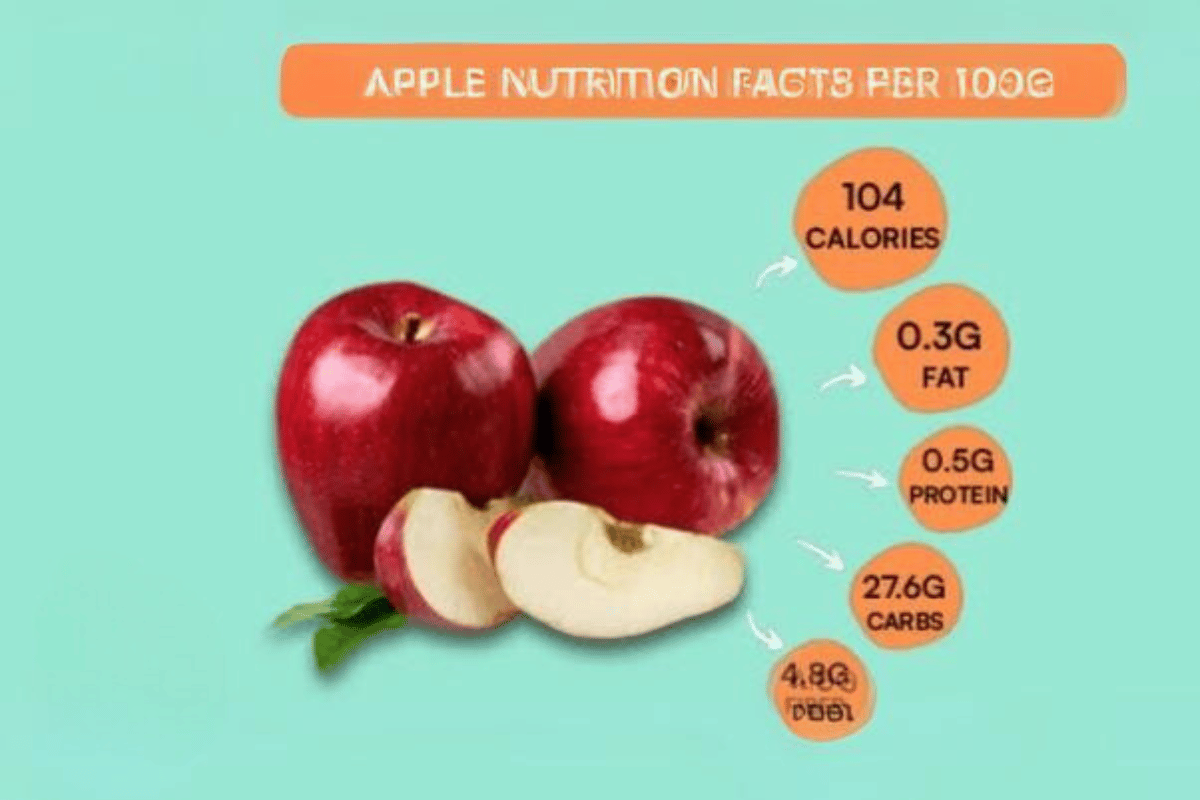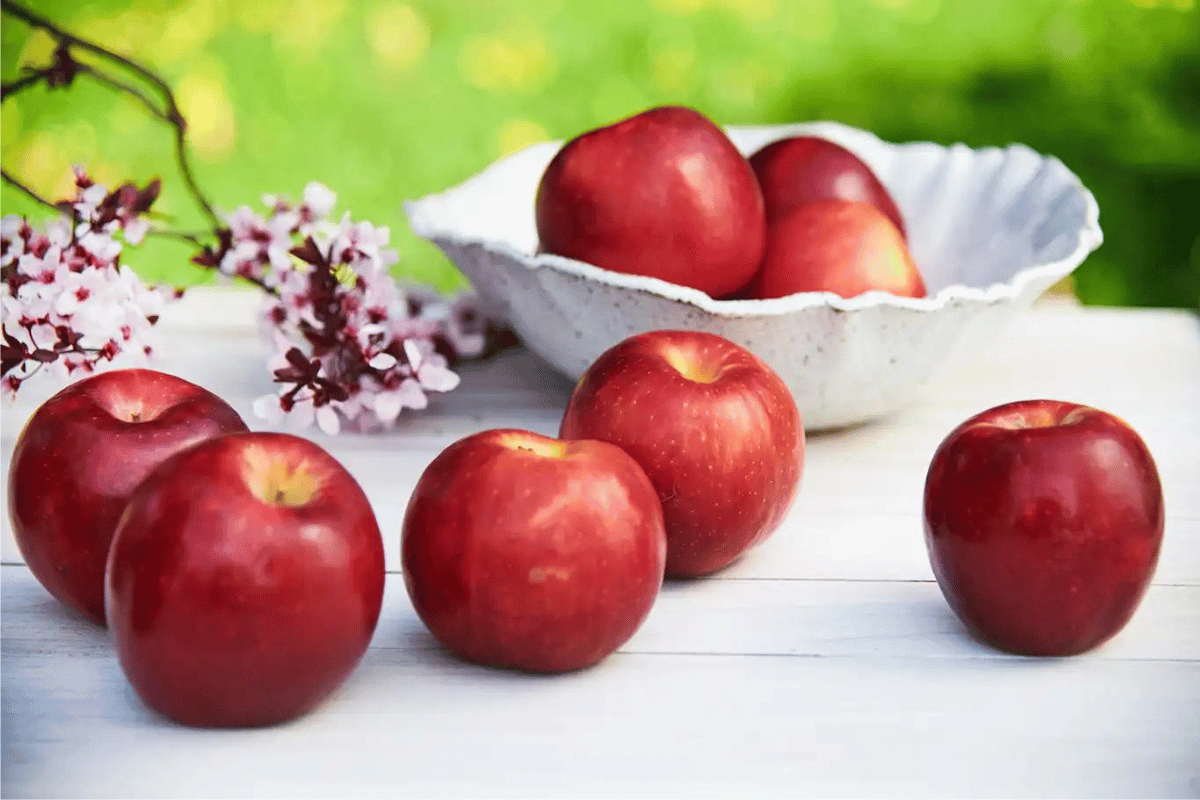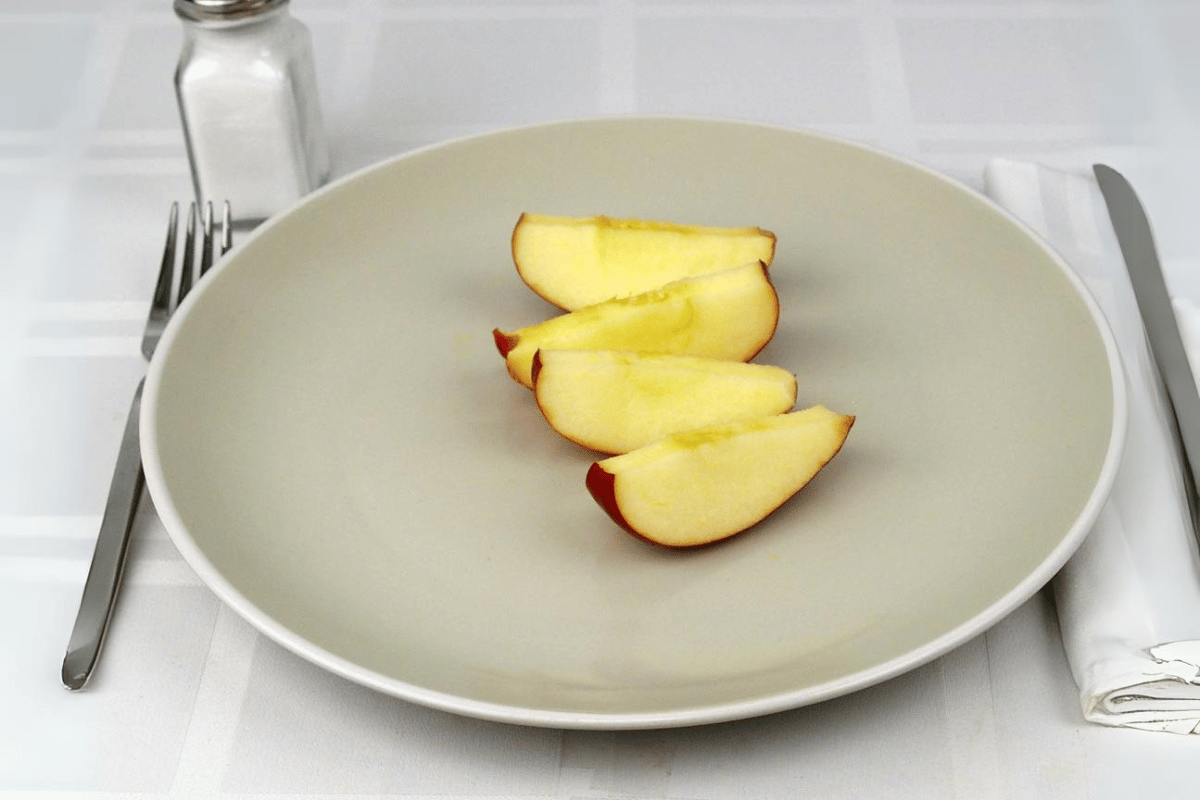Caloric counting is an essential method to control one’s weight. If people know how many calories are contained in their meals, they may make a decision about food and exercise while eating. This method is effective and very helpful if we want to get rid of excess weight.
Knowing how many calories you’re eating is crucial to weight loss because the amount of calories in each food item represents your total amount for the day. If you eat more calories than your body needs, you’ll gain weight. When you eat fewer calories than your body needs, you’ll lose weight. Therefore, your success with diet planning depends on knowing exactly what foods contain and, therefore, having knowledge of calorie value of apples is fundamental.
By including low-calorie, nutrient-rich foods such as the apple, you can set yourself up for weight loss. As we will see, the apple calories take up a surprisingly small percentage of your overall daily intake, making this food a great match for our weight loss plan.

Understanding Apple Calories
Apples are very healthy and have only relatively few calories, so they do qualify as a fruit that can be eaten as part of a losing weight diet. A medium-sized apple contains around 95 calories, of which approximately 90 per cent are carbs. The number of calories, however, can vary slightly.
By contrast, apples of different varieties – Granny Smith, Fuji or Gala, for example – can differ modestly in their calorie content. Granny Smiths, because they’re a bit more acidic and lower in sugar, are often seen as the lowest-calorie of the apples, and that’s probably true. But on the average, the difference is not overwhelming and probably doesn’t make any difference to most of us. Those who counted calories might consider such differences, though.
The caloric impact of an apple is further influenced by how it is prepared and consumed. Eaten raw, the apple is preserved in its entirety, including all its dietary fibre; therefore, it is considered beneficial for helping one lose weight because it promotes satiety and helps control hunger. The caloric impact of an apple changes once it’s cooked. Baked apples can gain calories depending on the other ingredients added to the final dish (sugar may get added to enhance the dessert). Furthermore, apple juice removes the fibre and concentrates the sugars, which significantly increases the calorie intake, while minimising the satiety effects of eating an apple.
Knowing these characteristics of apple calories is critical for a person interested in using apples via an apple weight loss diet. Natural variation in types of apple in their calorie content, and the effect of preparation on calorific value needs to be considered when planning a calorie-controlled diet.
How to Incorporate Apples into a Weight Loss Diet
If you’re trying to lose weight, there are strategic ways to eat apples to help you feel full and maintain a low-calorie diet. Apples are an excellent fruit because they are versatile, nutrient-rich and can be incorporated into the diet in many different creative ways that make them appealing.
The best way to include them in your diet is to replace the apples for a more caloric snack (I know, fewer calories than chips…) or for a condiment to boost the taste of salads, cereals or yogurt.
For the real creative types, there are countless low-calorie apple-inspired dishes to try. You could slice an apple and dust it with cinnamon, then bake it at 350˚F until it becomes tender and looks like a healthy dessert. You could cut an apple into a simple chicken salad to give it a nice crunch, or add some grated apple to your pancake or muffin batters for added fibre and natural sweetness – no need to add sugar.
It’s also wise to avoid passing up health benefits through some of the most common errors. These include eating too many processed apples, such as apple chips or apple juice, which often have emptier calories (from added sugars and without the fibre of whole apples) and can actively sabotage weight-loss efforts rather than support them.
With an understanding of how to maximise the utilisation of the apple calories while avoiding common pitfalls, you can use apples to not only help you lose weight, but also enjoy a variety of delicious nutritious dishes.

Benefits of Apples Beyond Calories
Sure, they’re low calorie, which is a benefit as far as it goes, but they’re also a nutrient bomb, chock full of fibre, vitamin C, and a variety of antioxidants. They’re therefore a boon to health and support weight loss.
One of the most important benefits of eating apples comes from the fact that they are high in dietary fibre. Fibre is linked to many aspects of digestive health, including keeping the bowels functioning properly. In addition, fibre-rich foods such as apples are particularly important in promoting healthy weight because they make people feel full, thereby reducing the likelihood that they will overeat. When they eat fibre-rich foods, people naturally eat fewer calories.
Apples are also a good source of the antioxidants such as quercetin, catechin and chlorogenic acid that help to reduce oxidative stress and inflammation, thereby making them potentially beneficial for heart health and reducing the risk of certain cancers.
Furthermore, the fibre content of the fruit helps to increase satiety, and the crunchiness of the fruit when masticated may satisfy oral cravings, which can trigger overeating. Apples can also decrease the demand for snacks with more refined sugars and fats by providing natural sweetness and a satisfying crunch.
Not only does it help you keep those calories down, incorporating apples into your diet also improves your nutrient intake, making you more likely to succeed in the long term with your diet and be healthier overall. This makes apples an ingredient of almost any diet, but particularly a weight-loss diet that aims to be healthy and sustainable.
Tracking Your Calorie Intake with Apples
So, as it relates to your caloric intake as it concerns fat loss, it is necessary to keep count of the calories in apples, and all other sources of food. Thankfully, there are tools and apps to help you keep track and stay on target with your goals.
One of the most popular ways to track calories is through special smartphone apps. For many, these apps are the first step in calorie-counting: the extremely popular MyFitnessPal, Lose It! or Cronometer apps centre around entering how much food you eat throughout the day and calculating a total calorie count by adding up what you input into these quantified food entries. These apps often feature large food databases for nearly any food under the Sun, sometimes even distinguishing between larger and smaller varieties, such as different kinds of apples or the difference between a large egg and a duck egg.
It’s also essential to measure and record your calories for the apples accurately. A medium-sized apple is generally 95 calories, but large and small apples may vary slightly – either way, weighing apples with a kitchen scale or using a portion size guide can help you track your calories exactly.
It would take thought and management to work your apple calories into your calorie goals for the day. You can’t eat all your apples and then decide that you can’t eat anything else. If your calorie goals are 2,000 calories a day and you wish to gain weight, you might eat six or seven apples a day (along with other healthy food of course). If your calorie goals are 1,500 a day and you are trying to lose weight, then you might use a few of your calories for apples each day, perhaps for a snack or in a meal.
You can track your apples by entering their calories (there are 95 calories in an apple), and stay on budget for the day; this is how you lose weight. In that way, the apples are part of the diet, but they are not the diet itself (they are like the fun, sexy sidekick to the boring, nerdy diet). The health benefits you get from eating apples are a nice side effect of weight loss, but they’re not the reason for it.

Conclusion
Overall, it is clear that counting calories of an apple can help losing weight and in a proper diet plan since it allows you to regulate your calorie intake better. By knowing how many calories there are in an apple and the way to include them in both meals and snacks, you can minimise the intake of calories in order to lose weight.
Apples are low in calories and provide dietary fibre, vitamins and antioxidants that contribute to health and wellbeing. In conclusion, apples are a good choice for those who want to lose weight healthily and sustainably.
Thanks to appropriate tools and apps, tracking calorie intake, including the calories coming from apples, has never been easier. Paying attention to portion sizes and daily goals of calorie intake, you will be able to ease your way with apples into your diet and reach your healthy weight goals.
in conclusion , eating apples to know the calories are only one of the measures that can help in losing weight. By eating a balanced diet with a plenty of nutritious food including apples for example and having an active lifestyle with practicing sports every week ,people will be able to lose weight in a healthy way.
apple calories
FAQ: Counting Apple Calories for Effective Weight Loss
Q1: Why are apples recommended for weight loss?
A1:Apple are great for the purpose of losing weight because they are very low in Calories but high in beneficial nutrients.An apple is made up of many tiny calories which along with its well-known explanation are considered to be healthy because they are high in dietary fibres as well as vitamins, minerals and antioxidants, which helps a person stay healthy by curbing hunger and craving.
Q2: How many calories are in an average-sized apple?
A2: An apple weighing about 140 grams has a caloric content of approximately 95 calories, but the caloric value may differ slightly due to the specific type and size of the apple.
Q3: Can I eat unlimited apples for weight loss?
Paraphrase: A3: Although apples can be part of a healthy diet, it is important to ensure that we don’t eat too many of them as, of course, calories in excess of our daily need will be stored as fat.
Q4: How can I incorporate apples into my weight loss diet?
A4: There are many ways to incorporate apples into a weight-loss plan: alone as a snack, in salads with lettuce, in yogurt with honey, or in recipes for low-fat baked goods or smoothies. Watch your portion sizes and do not add extra, high-calorie garnishes or ingredients to your apple foods.
Q5: Are there any apps to help track apple calories and overall calorie intake?
A5: Well yes. Many phone apps used to track calorie intake, for example, MyFitnessPal or Lose It!, or even apps that create a food diary, like Cronometer will track your calories from apples because the dietary and nutritional contents of different food items are in the internal data banks of each of the apps.
Q6: Can I lose weight by only eating apples?
Paraphrase: A6: While apples are a good food to include in a diet designed to help you lose weight, makes the mistake of assuming that apple juice or a few apples a day, or even as the only meal of the day, would help you lose weight – this is not the case. A balanced and varied diet, which includes a range of nutritious foods, will be necessary for a weight loss programme to be effective over time, and more generally successful in terms of your long-term health.
Q7: Are there any health benefits of apples beyond their calorie content?
A7: Yes, they are low in calories, but there’s no need to deny this, either. Apples are a great source of dietary fibre, which contributes to healthy digestion as well as a feeling of fullness. Apples also contain vitamins and other antioxidants which support general health and vitality.
Q8: How can I ensure I’m accurately tracking apple calories in my diet?
A8: You can track apple calories by weighing them on a kitchen scale, or by using guides to portion size. There’s only a little difference between varieties and size, so it’s not worth worrying about – keep that in mind when spreading them among your daily calorie targets.